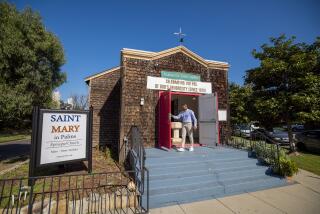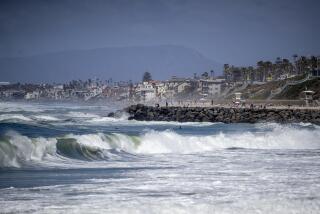In Search of Eternal Rest in Pasadena
Parishioners at a Pasadena church are hoping that the City Council will lay to rest Monday a more than century-old ban on all resting places for the dead within city limits.
In a rare but not unheard-of city policy dating back to the turn of the century, Pasadena land-use laws have prohibited cemeteries and mausoleums. In later years the ban also came to include columbaria--vaults with niches for urns containing ashes of the dead.
Even the Pasadena Cemetery Assn. is based in Altadena. Mountain View Cemetery, also in Altadena, is but a stone’s throw from the Pasadena border, and since the 1880s has been the preferred burial ground for many Pasadena residents.
But after a year of careful lobbying by All Saints Episcopal Church, the council is expected to lift this prohibition and allow churches and synagogues to keep cremated ashes in columbaria. All Saints, among the largest churches in Pasadena, plans a columbarium with 300 niches at its church, located in the shadow of Beaux Arts City Hall.
“Who would prefer being at Forest Lawn or Rose Hills to where they’ve prayed for generations?” said Russell Kully, a lawyer and All Saints senior warden. “Our family will be the first in line.”
Few California cities as old as Pasadena make no provisions for their dead. “It is an unusual practice,” said Bill Conway, executive director of the State Interment Assn.
“Even San Francisco, where all the cemeteries were moved out, still has a columbarium.”
But two trends more than a century apart may be responsible for Pasadena’s ban and the move to end it.
In the 1870s and 1880s, fear of the dead spreading disease ran rampant, historians said. Among the primary beliefs at the time was that decomposing bodies produced an unhealthy gas known as miasma, said one cemetery expert.
“Miasma theory became very important. Cemeteries, along with slaughterhouses, were considered a danger,” said David C. Sloane, author of “The Last Great Necessity: Cemeteries in American History.”
“Typically, at the time, major cemeteries were placed outside the city limits.”
Boston leaders built a cemetery in nearby Cambridge, and New York opted for Brooklyn, he said. A few cities enacted outright cemetery bans, said Sloane, who is a USC assistant professor of urban planning.
Levi Giddings acquired the 23-acre site for Mountain View in 1875, opening for burials in 1883. Among the first buried there was his daughter, whose grave was moved from near where the Tournament of Roses mansion is today. Three years later, Pasadena incorporated and drew its boundary a block or two south of the cemetery. A history of the city published in 1895 describes the property as “worthless land.”
One local history buff, Sue Mossman of Pasadena Heritage, said there is no proof that the city purposely drew its boundaries to exclude the cemetery.
In any case, pressure for burial grounds in Pasadena was probably reduced by the opening of the sprawling Forest Lawn cemetery in Los Angeles in 1917, Sloane said.
Denver Miller, Pasadena’s principal planner, said that because there is no mention of cemeteries or other types of resting places in city planning codes, such land use is illegal. He believes former city officials deliberately left out such uses because they did not want them.
But today, as cemeteries become crowded--Mountain View recently eliminated several roads to make room for more burial sites--cremations have increased from a handful in the 1960s to 21% of people who die nationwide and 42% in California.
When All Saints representatives asked the city last summer about building a columbarium, they were told it could not be done without changing the law to recognize such a land use for churches. “We were shocked,” said All Saints’ Kully. “Why in all these decades had it not come up before?”
Sloane said that in some ways, these columbarium niches reflect a return to ways of medieval Europe and early America, where those with the most status in society were buried in the cathedral or abbey. He said columbaria are also a source of income for churches and benefit their members.
“A lot of churches are going to columbaria these days,” said the Rev. Robert Gaestel of the Church of the Angels on Pasadena’s Avenue 64.
More to Read
Sign up for Essential California
The most important California stories and recommendations in your inbox every morning.
You may occasionally receive promotional content from the Los Angeles Times.











